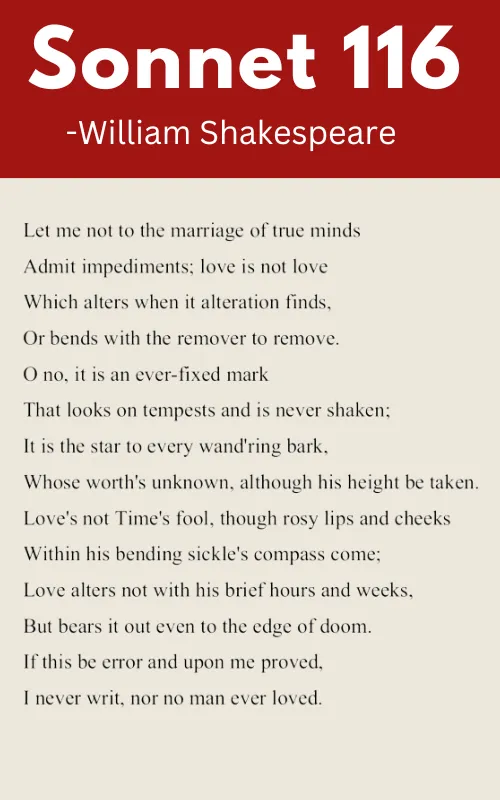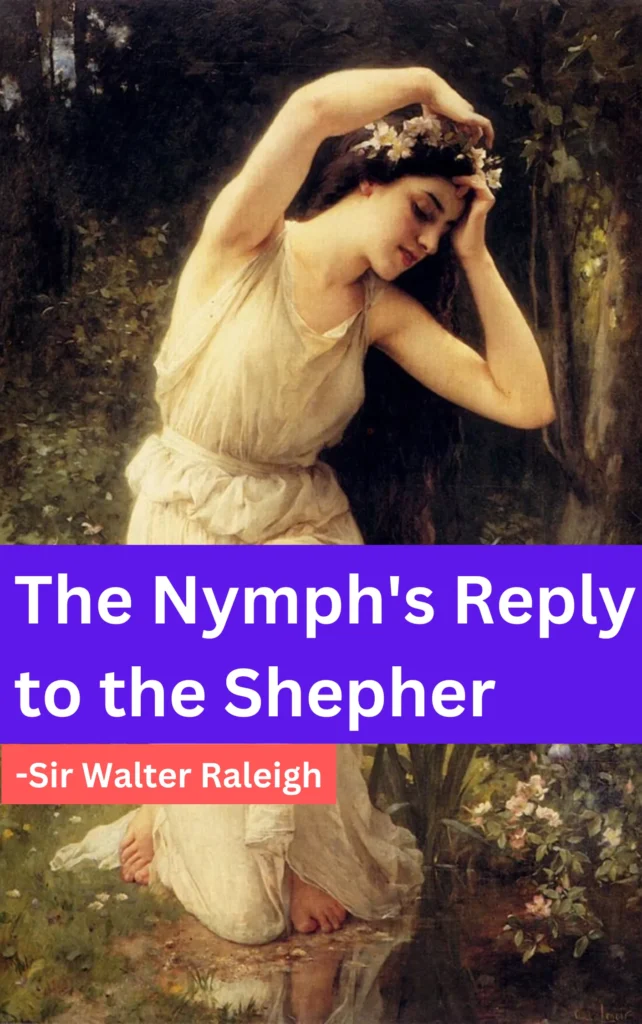About the Poem “Sonnet 116”
| Poem Title | Sonnet 116 |
| Author | William Shakespeare |
| Date | 1609 |
| Form | Shakespearean sonnet |
| Structure | 14 lines |
| Tone | Assertive, passionate, semi-autobiographical |
| Meter | Iambic pentameter |
| Rhyme scheme | ABAB CDCD EFEF GG |
| Themes | True love, beauty, mortality |
| Poetic devices | Alliteration, hyperbole, metaphor, personification, polyptoton, paradox |
Themes of Sonnet 116
The main themes of Shakespeare’s “Sonnet 116” in simple language:
- Unchanging Love ➤ The poem emphasizes that true love remains constant and unwavering, even when faced with difficulties or the passage of time.
- Enduring Love ➤ It suggests that real love lasts forever, and nothing can change or weaken it.
- Love Beyond Appearances ➤ The poem argues that genuine love is not based on physical beauty or material possessions but goes deeper, valuing the inner qualities of a person.
- Guiding Force ➤ Love is portrayed as a steady and guiding force that can withstand life’s storms and challenges.
“Sonnet 116” Poem by William Shakespeare
Let me not to the marriage of true minds
Admit impediments. Love is not love
Which alters when it alteration finds,
Or bends with the remover to remove.
O no! it is an ever-fixed mark
That looks on tempests and is never shaken;
It is the star to every wand’ring bark,
Whose worth’s unknown, although his height be taken.
Love’s not Time’s fool, though rosy lips and cheeks
Within his bending sickle’s compass come;
Love alters not with his brief hours and weeks,
But bears it out even to the edge of doom.
If this be error and upon me prov’d,
I never writ, nor no man ever lov’d.
Wacth “Sonnet 116” Poem Summary on YouTube
Sonnet 116 Summary & Analysis
Sonnet 116 is one of the most famous and well-known poems in English. It is a celebration of true love, which Shakespeare defines as a constant and unchanging union of minds and souls. The poem is structured as a sonnet, which is a 14-line poem with a specific rhyme scheme.
The sonnet’s first quatrain introduces the speaker’s definition of true love. It is “not Time’s fool,” he says, implying that it is unaffected by the passage of time or the changes that life brings. True love is also “ever-fixed,” which means it is unchanging and constant.
In the second quatrain, the speaker compares true love to a guiding star. He describes it as a beacon of light in the darkness of life, guiding lovers through difficult times. True love is also “more steadfast than the Pole Star,” which means it is more consistent and consistent than the North Star.
The sonnet’s third quatrain describes the effects of true love on lovers. It makes them “better selves,” according to the speaker, and it helps them grow and mature. True love also strengthens and fortifies lovers.
The final couplet of the sonnet is a powerful statement about the speaker’s faith in true love. He says that if he is wrong about the nature of true love, then no man has ever truly loved.
FAQs from Sonnet 116
What is the message of Sonnet 116?
The message of Sonnet 116 is: True love is eternal and unchanging.
Is Sonnet 116 positive or negative?
Sonnet 116 is a positive poem about the enduring nature of true love.
How does Shakespeare define true love?
True love is eternal, unchanging, and a guiding light in the darkness.
What might the sickle in Sonnet 116 symbolize?
The sickle symbolizes the passage of time and the inevitability of death.
What do the last two lines of Sonnet 116 mean?
The speaker asserts that if their definition of true love is wrong, then no one has ever loved.











